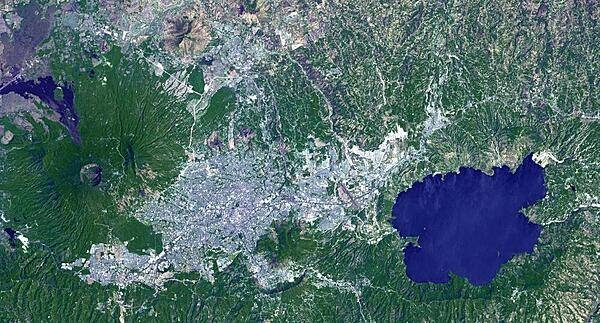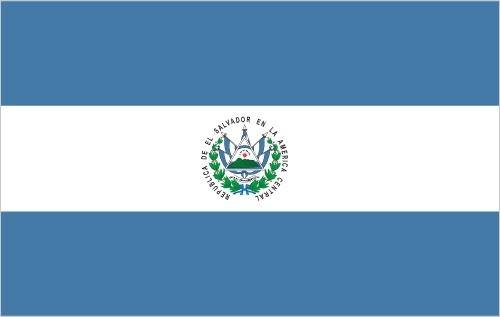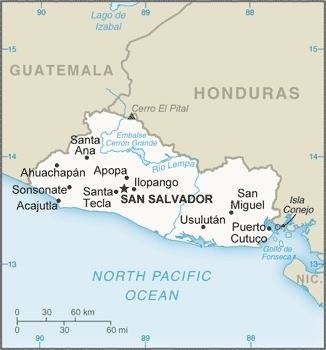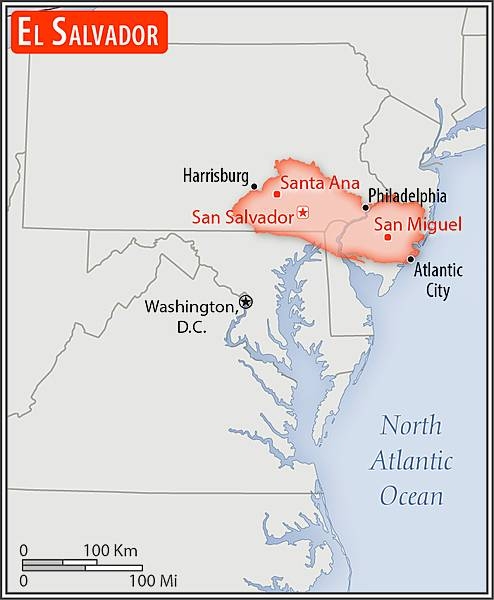Introduction
Background
El Salvador achieved independence from Spain in 1821 and from the Central American Federation in 1839. A 12-year civil war, which cost about 75,000 lives, was brought to a close in 1992 when the government and leftist rebels signed a treaty that provided for military and political reforms. El Salvador is beset by one of the world's highest homicide rates and pervasive criminal gangs.
Visit the Definitions and Notes page to view a description of each topic.
Geography
Location
Central America, bordering the North Pacific Ocean, between Guatemala and Honduras
Geographic coordinates
13 50 N, 88 55 W
Map references
Central America and the Caribbean
Land boundaries
total: 590 km
border countries (2): Guatemala 199 km; Honduras 391 km
Coastline
307 km
Maritime claims
territorial sea: 12 nm
contiguous zone: 24 nm
exclusive economic zone: 200 nm
Climate
tropical; rainy season (May to October); dry season (November to April); tropical on coast; temperate in uplands
Terrain
mostly mountains with narrow coastal belt and central plateau
Elevation
highest point: Cerro El Pital 2,730 m
lowest point: Pacific Ocean 0 m
mean elevation: 442 m
Natural resources
hydropower, geothermal power, petroleum, arable land
Land use
agricultural land: 74.7% (2018 est.)
arable land: 33.1% (2018 est.)
permanent crops: 10.9% (2018 est.)
permanent pasture: 30.7% (2018 est.)
forest: 13.6% (2018 est.)
other: 11.7% (2018 est.)
Irrigated land
274 sq km (2020)
Population distribution
athough it is the smallest country in land area in Central America, El Salvador has a population that is 18 times larger than Belize; at least 20% of the population lives abroad; high population density country-wide, with particular concentration around the capital of San Salvador
Natural hazards
known as the Land of Volcanoes; frequent and sometimes destructive earthquakes and volcanic activity; extremely susceptible to hurricanes
volcanism: significant volcanic activity; San Salvador (1,893 m), which last erupted in 1917, has the potential to cause major harm to the country's capital, which lies just below the volcano's slopes; San Miguel (2,130 m), which last erupted in 2002, is one of the most active volcanoes in the country; other historically active volcanoes include Conchaguita, Ilopango, Izalco, and Santa Ana
Geography - note
smallest Central American country and only one without a coastline on the Caribbean Sea
People and Society
Nationality
noun: Salvadoran(s)
adjective: Salvadoran
Ethnic groups
Mestizo 86.3%, White 12.7%, Amerindian 0.2% (includes Lenca, Kakawira, Nahua-Pipil), Black 0.1%, other 0.6% (2007 est.)
Languages
Spanish (official), Nawat (among some Amerindians)
major-language sample(s):
La Libreta Informativa del Mundo, la fuente indispensable de información básica. (Spanish)
The World Factbook, the indispensable source for basic information.
Religions
Roman Catholic 50%, Protestant 36%, other 2%, none 12% (2014 est.)
Demographic profile
El Salvador is the smallest and most densely populated country in Central America. It is well into its demographic transition, experiencing slower population growth, a decline in its number of youths, and the gradual aging of its population. The increased use of family planning has substantially lowered El Salvador's fertility rate, from approximately 6 children per woman in the 1970s to replacement level today. A 2008 national family planning survey showed that female sterilization remained the most common contraception method in El Salvador - its sterilization rate is among the highest in Latin America and the Caribbean - but that the use of injectable contraceptives is growing. Fertility differences between rich and poor and urban and rural women are narrowing.
Salvadorans fled during the 1979 to 1992 civil war mainly to the United States but also to Canada and to neighboring Mexico, Guatemala, Honduras, Nicaragua, and Costa Rica. Emigration to the United States increased again in the 1990s and 2000s as a result of deteriorating economic conditions, natural disasters (Hurricane Mitch in 1998 and earthquakes in 2001), and family reunification. At least 20% of El Salvador's population lives abroad. The remittances they send home account for close to 20% of GDP, are the second largest source of external income after exports, and have helped reduce poverty.
Age structure
0-14 years: 25.83% (male 857,003/female 817,336)
15-24 years: 18.82% (male 619,368/female 600,501)
25-54 years: 40.51% (male 1,221,545/female 1,404,163)
55-64 years: 7.23% (male 198,029/female 270,461)
65 years and over: 7.6% (male 214,717/female 277,979) (2020 est.)
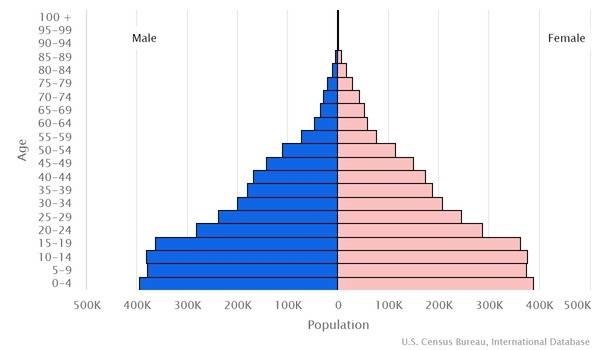
Dependency ratios
total dependency ratio: 51.3
youth dependency ratio: 39
elderly dependency ratio: 12.3
potential support ratio: 8.1 (2021 est.)
Median age
total: 27.7 years
male: 26.2 years
female: 29.3 years (2020 est.)
Population distribution
athough it is the smallest country in land area in Central America, El Salvador has a population that is 18 times larger than Belize; at least 20% of the population lives abroad; high population density country-wide, with particular concentration around the capital of San Salvador
Urbanization
urban population: 75.4% of total population (2023)
rate of urbanization: 1.33% annual rate of change (2020-25 est.)
Major urban areas - population
1.116 million SAN SALVADOR (capital) (2023)
Sex ratio
at birth: 1.05 male(s)/female
0-14 years: 1.05 male(s)/female
15-24 years: 1.03 male(s)/female
25-54 years: 0.87 male(s)/female
55-64 years: 0.72 male(s)/female
65 years and over: 0.68 male(s)/female
total population: 0.92 male(s)/female (2022 est.)
Mother's mean age at first birth
20.8 years (2008 est.)
note: data represents median age at first birth among women 25-29
Maternal mortality ratio
46 deaths/100,000 live births (2017 est.)
country comparison to the world: 95Infant mortality rate
total: 12.14 deaths/1,000 live births
male: 13.79 deaths/1,000 live births
female: 10.41 deaths/1,000 live births (2022 est.)
Life expectancy at birth
total population: 75.37 years
male: 71.88 years
female: 79.04 years (2022 est.)
Contraceptive prevalence rate
71.9% (2014)
Drinking water source
improved: urban: 99.6% of population
rural: 94.2% of population
total: 98.2% of population
unimproved: urban: 0.4% of population
rural: 5.8% of population
total: 1.8% of population (2020 est.)
Current health expenditure
7.2% of GDP (2019)
Physicians density
2.87 physicians/1,000 population (2018)
Hospital bed density
1.2 beds/1,000 population (2017)
Sanitation facility access
improved: urban: 100% of population
rural: 97.1% of population
total: 99.2% of population
unimproved: urban: 0% of population
rural: 2.9% of population
total: 0.8% of population (2020 est.)
Major infectious diseases
degree of risk: high (2020)
food or waterborne diseases: bacterial and protozoal diarrhea
vectorborne diseases: dengue fever
Alcohol consumption per capita
total: 2.94 liters of pure alcohol (2019 est.)
beer: 1.5 liters of pure alcohol (2019 est.)
wine: 0.06 liters of pure alcohol (2019 est.)
spirits: 1.37 liters of pure alcohol (2019 est.)
other alcohols: 0 liters of pure alcohol (2019 est.)
Tobacco use
total: 7.9% (2020 est.)
male: 14.1% (2020 est.)
female: 1.7% (2020 est.)
Literacy
definition: age 15 and over can read and write
total population: 89.1%
male: 91.3%
female: 87.3% (2019)
School life expectancy (primary to tertiary education)
total: 12 years
male: 12 years
female: 12 years (2018)
Youth unemployment rate (ages 15-24)
total: 11.6%
male: 9.6%
female: 15.1% (2020)
Environment
Environment - current issues
deforestation; soil erosion; water pollution; contamination of soils from disposal of toxic wastes
Environment - international agreements
party to: Biodiversity, Climate Change, Climate Change-Kyoto Protocol, Climate Change-Paris Agreement, Comprehensive Nuclear Test Ban, Desertification, Endangered Species, Hazardous Wastes, Nuclear Test Ban, Ozone Layer Protection, Ship Pollution, Wetlands
signed, but not ratified: Law of the Sea
Air pollutants
particulate matter emissions: 23.42 micrograms per cubic meter (2016 est.)
carbon dioxide emissions: 7.17 megatons (2016 est.)
methane emissions: 4.71 megatons (2020 est.)
Climate
tropical; rainy season (May to October); dry season (November to April); tropical on coast; temperate in uplands
Land use
agricultural land: 74.7% (2018 est.)
arable land: 33.1% (2018 est.)
permanent crops: 10.9% (2018 est.)
permanent pasture: 30.7% (2018 est.)
forest: 13.6% (2018 est.)
other: 11.7% (2018 est.)
Urbanization
urban population: 75.4% of total population (2023)
rate of urbanization: 1.33% annual rate of change (2020-25 est.)
Revenue from forest resources
forest revenues: 0.6% of GDP (2018 est.)
country comparison to the world: 62Major infectious diseases
degree of risk: high (2020)
food or waterborne diseases: bacterial and protozoal diarrhea
vectorborne diseases: dengue fever
Waste and recycling
municipal solid waste generated annually: 1,648,996 tons (2010 est.)
Total water withdrawal
municipal: 474 million cubic meters (2017 est.)
industrial: 213 million cubic meters (2017 est.)
agricultural: 1.431 billion cubic meters (2017 est.)
Total renewable water resources
26.27 billion cubic meters (2017 est.)
Government
Country name
conventional long form: Republic of El Salvador
conventional short form: El Salvador
local long form: Republica de El Salvador
local short form: El Salvador
etymology: name is an abbreviation of the original Spanish conquistador designation for the area "Provincia de Nuestro Senor Jesus Cristo, el Salvador del Mundo" (Province of Our Lord Jesus Christ, the Saviour of the World), which became simply "El Salvador" (The Savior)
Government type
presidential republic
Capital
name: San Salvador
geographic coordinates: 13 42 N, 89 12 W
time difference: UTC-6 (1 hour behind Washington, DC, during Standard Time)
etymology: Spanish for "Holy Savior" (referring to Jesus Christ)
Administrative divisions
14 departments (departamentos, singular - departamento); Ahuachapan, Cabanas, Chalatenango, Cuscatlan, La Libertad, La Paz, La Union, Morazan, San Miguel, San Salvador, San Vicente, Santa Ana, Sonsonate, Usulutan
Independence
15 September 1821 (from Spain)
National holiday
Independence Day, 15 September (1821)
Constitution
history: many previous; latest drafted 16 December 1983, enacted 23 December 1983
amendments: proposals require agreement by absolute majority of the Legislative Assembly membership; passage requires at least two-thirds majority vote of the Assembly; constitutional articles on basic principles, and citizen rights and freedoms cannot be amended; amended 2003, 2009, 2014
Legal system
civil law system with minor common law influence; judicial review of legislative acts in the Supreme Court
International law organization participation
has not submitted an ICJ jurisdiction declaration; non-party state to the ICCt
Citizenship
citizenship by birth: yes
citizenship by descent only: yes
dual citizenship recognized: yes
residency requirement for naturalization: 5 years
Suffrage
18 years of age; universal
Executive branch
chief of state: President Nayib Armando BUKELE Ortez (since 1 June 2019); Vice President Felix Augusto Antonio ULLOA Garay (since 1 June 2019); note - the president is both chief of state and head of government
head of government: President Nayib Armando BUKELE Ortez (since 1 June 2019); Vice President Felix Augusto Antonio ULLOA Garay (since 1 June 2019)
cabinet: Council of Ministers selected by the president
elections/appointments: president and vice president directly elected on the same ballot by absolute majority popular vote in 2 rounds if needed for a single 5-year term; election last held on 3 February 2019 (next to be held on February 2024)
election results:
2019: Nayib Armando BUKELE Ortez elected president - Nayib Armando BUKELE Ortez (GANA) 53.1%, Carlos CALLEJA Hakker (ARENA) 31.72%, Hugo MARTINEZ (FMLN) 14.41%, other 0.77%
2014: Salvador SANCHEZ CEREN elected president in second round; percent of vote in first round - Salvador SANCHEZ CEREN (FMLN) 48.9%, Norman QUIJANO (ARENA) 39%, Antonio SACA (CN) 11.4%, other 0.7%; percent of vote in second round - Salvador SANCHEZ CEREN 50.1%, Norman QUIJANO 49.9%
Legislative branch
description: unicameral Legislative Assembly or Asamblea Legislativa (84 seats; members directly elected in multi-seat constituencies and a single nationwide constituency by proportional representation vote to serve 3-year terms)
elections: last held on 28 February 2021 (next to be held in 2024)
election results: percent of vote by party - NI 66.46%, ARENA 12.18%, FMLN 6.91%, GANA 5.29%, PCN 4.08%, NT 1.7%, PDC 1.7%, V 1.01%; seats by party - NI 56, ARENA 14, GANA 5, FMLN 4, PCN 2, PDC 1, NT 1, V 1; composition - men 61, women 23, percent of women 27.4%
Judicial branch
highest court(s): Supreme Court or Corte Suprema de Justicia (consists of 15 judges, including its president, and 15 substitute judges organized into Constitutional, Civil, Penal, and Administrative Conflict Chambers)
judge selection and term of office: judges elected by the Legislative Assembly on the recommendation of both the National Council of the Judicature, an independent body elected by the Legislative Assembly, and the Bar Association; judges elected for 9-year terms, with renewal of one-third of membership every 3 years; consecutive reelection is allowed
subordinate courts: Appellate Courts; Courts of First Instance; Courts of Peace
Political parties and leaders
Christian Democratic Party or PDC [Reynaldo CARBALLO]
Farabundo Marti National Liberation Front or FMLN [Oscar ORTIZ]
Great Alliance for National Unity or GANA [Nelson GUARDADO]
National Coalition Party or PCN [Manuel RODRIGUEZ]
Nationalist Republican Alliance or ARENA [Erick SALGUERO]
New Ideas (Nuevas Ideas) or NI [Xavier Zablah BUKELE]
Our Time (Nuestro Tiempo) or NT [Juan VALIENTE]
Vamos or V [Josue ALVARADO Flores]
International organization participation
BCIE, CACM, CD, CELAC, FAO, G-11, G-77, IADB, IAEA, IBRD, ICAO, ICC (national committees), ICRM, IDA, IFAD, IFC, IFRCS, ILO, IMF, IMO, Interpol, IOC, IOM, IPU, ISO (correspondent), ITSO, ITU, ITUC (NGOs), LAES, LAIA (observer), MIGA, MINURSO, MINUSTAH, NAM (observer), OAS, OPANAL, OPCW, Pacific Alliance (observer), PCA, Petrocaribe, SICA, UN, UNCTAD, UNESCO, UNIDO, UNIFIL, Union Latina, UNISFA, UNMISS, UNOCI, UNWTO, UPU, WCO, WFTU (NGOs), WHO, WIPO, WMO, WTO
Diplomatic representation in the US
chief of mission: Ambassador Carmen Milena MAYORGA VALERA (since 23 December 2020)
chancery: 1400 16th Street NW, Suite 100, Washington, DC 20036
telephone: [1] (202) 595-7500
FAX: [1] (202) 232-3763
email address and website:
correo@elsalvador.org
consulate(s) general: Atlanta, Boston, Brentwood (NY), Charlotte, Chicago, Dallas, Denver, Houston, Las Vegas (NV), Loreado (TX), Los Angeles, McAllen (TX), New York, San Bernardino (CA), San Francisco, Tucson (AZ), Washington (DC), Woodbridge (VA)
Diplomatic representation from the US
chief of mission: Ambassador (vacant); Charge d'Affaires Patrick H. VENTRELL
embassy: Final Boulevard Santa Elena, Antiguo Cuscatlan, La Libertad, San Salvador
mailing address: 3450 San Salvador Place, Washington, DC 20521-3450
telephone: [503] 2501-2999
FAX: [503] 2501-2150
email address and website:
ACSSanSal@state.gov
https://sv.usembassy.gov/
Flag description
three equal horizontal bands of cobalt blue (top), white, and cobalt blue with the national coat of arms centered in the white band; the coat of arms features a round emblem encircled by the words REPUBLICA DE EL SALVADOR EN LA AMERICA CENTRAL; the banner is based on the former blue-white-blue flag of the Federal Republic of Central America; the blue bands symbolize the Pacific Ocean and the Caribbean Sea, while the white band represents the land between the two bodies of water, as well as peace and prosperity
note: similar to the flag of Nicaragua, which has a different coat of arms centered in the white band; also similar to the flag of Honduras, which has five blue stars arranged in an X pattern centered in the white band
National symbol(s)
turquoise-browed motmot (bird); national colors: blue, white
National anthem
name: "Himno Nacional de El Salvador" (National Anthem of El Salvador)
lyrics/music: Juan Jose CANAS/Juan ABERLE
note: officially adopted 1953, in use since 1879; at 4:20 minutes, the anthem of El Salvador is one of the world's longest
National heritage
total World Heritage Sites: 1 (cultural)
selected World Heritage Site locales: Joya de Cerén Archaeological Site
Economy
Economic overview
The smallest country in Central America geographically, El Salvador has the fourth largest economy in the region. With the global recession, real GDP contracted in 2009 and economic growth has since remained low, averaging less than 2% from 2010 to 2014, but recovered somewhat in 2015-17 with an average annual growth rate of 2.4%. Remittances accounted for approximately 18% of GDP in 2017 and were received by about a third of all households.
In 2006, El Salvador was the first country to ratify the Dominican Republic-Central American Free Trade Agreement, which has bolstered the export of processed foods, sugar, and ethanol, and supported investment in the apparel sector amid increased Asian competition. In September 2015, El Salvador kicked off a five-year $277 million second compact with the Millennium Challenge Corporation - a US Government agency aimed at stimulating economic growth and reducing poverty - to improve El Salvador's competitiveness and productivity in international markets.
The Salvadoran Government maintained fiscal discipline during reconstruction and rebuilding following earthquakes in 2001 and hurricanes in 1998 and 2005, but El Salvador's public debt, estimated at 59.3% of GDP in 2017, has been growing over the last several years.
Real GDP (purchasing power parity)
$52.26 billion (2020 est.)
$56.77 billion (2019 est.)
$55.31 billion (2018 est.)
note: data are in 2017 dollars
Real GDP growth rate
2.3% (2017 est.)
2.6% (2016 est.)
2.4% (2015 est.)
Real GDP per capita
$8,100 (2020 est.)
$8,800 (2019 est.)
$8,600 (2018 est.)
note: data are in 2017 dollars
GDP (official exchange rate)
$27.023 billion (2019 est.)
Inflation rate (consumer prices)
0% (2019 est.)
1% (2018 est.)
1% (2017 est.)
Credit ratings
Fitch rating: B- (2017)
Moody's rating: B3 (2018)
Standard & Poors rating: B- (2018)
note: The year refers to the year in which the current credit rating was first obtained.
GDP - composition, by sector of origin
agriculture: 12% (2017 est.)
industry: 27.7% (2017 est.)
services: 60.3% (2017 est.)
GDP - composition, by end use
household consumption: 84.5% (2017 est.)
government consumption: 15.8% (2017 est.)
investment in fixed capital: 16.9% (2017 est.)
investment in inventories: 0% (2017 est.)
exports of goods and services: 27.6% (2017 est.)
imports of goods and services: -44.9% (2017 est.)
Agricultural products
sugar cane, maize, milk, poultry, sorghum, beans, coconuts, eggs, apples, oranges
Industries
food processing, beverages, petroleum, chemicals, fertilizer, textiles, furniture, light metals
Labor force - by occupation
agriculture: 21%
industry: 20%
services: 58% (2011 est.)
Unemployment rate
7% (2017 est.)
6.9% (2016 est.)
note: data are official rates; but underemployment is high
Youth unemployment rate (ages 15-24)
total: 11.6%
male: 9.6%
female: 15.1% (2020)
Population below poverty line
22.8% (2019 est.)
Gini Index coefficient - distribution of family income
38.6 (2018 est.)
38 (2014)
Household income or consumption by percentage share
lowest 10%: 2.2%
highest 10%: 32.3% (2014 est.)
Budget
revenues: 5.886 billion (2017 est.)
expenditures: 6.517 billion (2017 est.)
Public debt
67.9% of GDP (2017 est.)
66.4% of GDP (2016 est.)
note: El Salvador's total public debt includes non-financial public sector debt, financial public sector debt, and central bank debt
Fiscal year
calendar year
Current account balance
-$501 million (2017 est.)
-$500 million (2016 est.)
Exports
$6.29 billion (2020 est.) note: data are in current year dollars
$7.98 billion (2019 est.) note: data are in current year dollars
$7.56 billion (2018 est.) note: data are in current year dollars
Exports - partners
United States 40%, Guatemala 15%, Honduras 15%, Nicaragua 6% (2019)
Exports - commodities
textiles and apparel, electrical capacitors, plastic lids, raw sugar, toilet paper (2019)
Imports
$10.82 billion (2020 est.) note: data are in current year dollars
$12.45 billion (2019 est.) note: data are in current year dollars
$12.32 billion (2018 est.) note: data are in current year dollars
Imports - partners
United States 30%, China 14%, Guatemala 13%, Mexico 8%, Honduras 6% (2019)
Imports - commodities
refined petroleum, packaged medicines, clothing, broadcasting equipment, natural gas (2019)
Reserves of foreign exchange and gold
$3.567 billion (31 December 2017 est.)
$3.238 billion (31 December 2016 est.)
Debt - external
$17.24 billion (2019 est.)
$16.712 billion (2018 est.)
Exchange rates
note: the US dollar is used as a medium of exchange and circulates freely in the economy
1 (2017 est.)
Energy
Electricity access
electrification - total population: 97% (2019)
electrification - urban areas: 99% (2019)
electrification - rural areas: 93% (2019)
Electricity
installed generating capacity: 2.586 million kW (2020 est.)
consumption: 6,443,200,000 kWh (2019 est.)
exports: 158 million kWh (2019 est.)
imports: 1.45 billion kWh (2019 est.)
transmission/distribution losses: 795.8 million kWh (2019 est.)
Electricity generation sources
fossil fuels: 28.2% of total installed capacity (2020 est.)
nuclear: 0% of total installed capacity (2020 est.)
solar: 7.5% of total installed capacity (2020 est.)
wind: 0% of total installed capacity (2020 est.)
hydroelectricity: 30% of total installed capacity (2020 est.)
tide and wave: 0% of total installed capacity (2020 est.)
geothermal: 22.2% of total installed capacity (2020 est.)
biomass and waste: 12.1% of total installed capacity (2020 est.)
Coal
production: 0 metric tons (2020 est.)
consumption: 1,000 metric tons (2020 est.)
exports: 0 metric tons (2020 est.)
imports: 1,000 metric tons (2020 est.)
proven reserves: 0 metric tons (2019 est.)
Petroleum
total petroleum production: 0 bbl/day (2021 est.)
refined petroleum consumption: 59,100 bbl/day (2019 est.)
crude oil and lease condensate exports: 0 bbl/day (2018 est.)
crude oil and lease condensate imports: 0 bbl/day (2018 est.)
crude oil estimated reserves: 0 barrels (2021 est.)
Natural gas
production: 0 cubic meters (2021 est.)
consumption: 0 cubic meters (2021 est.)
exports: 0 cubic meters (2021 est.)
imports: 0 cubic meters (2021 est.)
proven reserves: 0 cubic meters (2021 est.)
Carbon dioxide emissions
7.632 million metric tonnes of CO2 (2019 est.)
from coal and metallurgical coke: 2,000 metric tonnes of CO2 (2019 est.)
from petroleum and other liquids: 7.63 million metric tonnes of CO2 (2019 est.)
from consumed natural gas: 0 metric tonnes of CO2 (2019 est.)
Energy consumption per capita
24.124 million Btu/person (2019 est.)
country comparison to the world: 131Communications
Telephones - fixed lines
total subscriptions: 894,000 (2020 est.)
subscriptions per 100 inhabitants: 14 (2020 est.)
Telephones - mobile cellular
total subscriptions: 9.949 million (2020 est.)
subscriptions per 100 inhabitants: 153 (2020 est.)
Telecommunication systems
general assessment: El Salvador is the smallest country in central America geographically, it has the fourth largest economy in the region; the country’s telecom sector has been restricted by poor infrastructure and unequal income distribution; there have been organizational delays which have slowed the development of telecom services; El Salvador’s fixed-line teledensity is substantially lower than the Latin American and Caribbean average; there has been a significant drop in the number of fixed lines since 2010, particularly in 2017, largely due to the substitution for mobile-only alternatives; about 94% of all telephony lines in the country are on mobile networks; mobile subscriptions are remarkably high considering El Salvador’s economic indicators, being about a third higher than average for Latin America and the Caribbean; the country was one of the last in the region to provide LTE services, mainly due to the inadequate provision of suitable spectrum; the multi-spectrum auction conducted at the end of 2019 has allowed MNOs to improve the reach and quality of their service offerings; El Salvador’s telecom legislation is one of the more liberal in Latin America, encouraging competition in most areas and permitting foreign investment; there are no regulations which promote wholesale broadband; the only effective cross-platform competition in the broadband market comes from the few cable operators; there has been some market consolidation in recent years (2021)
domestic: fixed-line services, roughly 14 per 100, has slowed in the face of mobile-cellular competition now at 153 subscribers per 100 inhabitants (2020)
international: country code - 503; satellite earth station - 1 Intelsat (Atlantic Ocean); connected to Central American Microwave System (2019)
note: the COVID-19 pandemic continues to have a significant impact on production and supply chains globally; since 2020, some aspects of the telecom sector have experienced a downturn, particularly in mobile device production; progress toward 5G implementation has resumed, as well as upgrades to infrastructure; consumer spending on telecom services has increased due to the surge in demand for capacity and bandwidth; the crucial nature of telecom services as a tool for work and school from home is still evident, and the spike in this area has seen growth opportunities for development of new tools and increased services
Broadcast media
multiple privately owned national terrestrial TV networks, supplemented by cable TV networks that carry international channels; hundreds of commercial radio broadcast stations and two known government-owned radio broadcast station; transition to digital transmission to begin in 2018 along with adaptation of the Japanese-Brazilian Digital Standard (ISDB-T) (2022)
Internet users
total: 3,567,410 (2020 est.)
percent of population: 55% (2020 est.)
Broadband - fixed subscriptions
total: 586,000 (2020 est.)
subscriptions per 100 inhabitants: 9 (2020 est.)
Transportation
National air transport system
number of registered air carriers: 1 (2020)
inventory of registered aircraft operated by air carriers: 13
annual passenger traffic on registered air carriers: 2,545,105 (2018)
annual freight traffic on registered air carriers: 10.73 million (2018) mt-km
Airports - with paved runways
total: 5
over 3,047 m: 1
1,524 to 2,437 m: 1
914 to 1,523 m: 2
under 914 m: 1 (2021)
Airports - with unpaved runways
total: 63
1,524 to 2,437 m: 1
914 to 1,523 m: 11
under 914 m: 51 (2021)
Heliports
2 (2021)
Railways
total: 12.5 km (2014)
narrow gauge: 12.5 km (2014) 0.914-mm gauge
Roadways
total: 9,012 km (2017)
paved: 5,341 km (2017)
unpaved: 3,671 km (2017)
Waterways
422 km (2022) (Rio Lempa River is partially navigable by small craft)
country comparison to the world: 95Ports and terminals
major seaport(s): Puerto Cutuco
oil terminal(s): Acajutla offshore terminal
Military and Security
Military and security forces
the Armed Force of El Salvador (La Fuerza Armada de El Salvador, FAES): Army of El Salvador (Ejercito de El Salvador, ES), Navy of El Salvador (Fuerza Naval de El Salvador, FNES), Salvadoran Air Force (Fuerza Aerea Salvadorena, FAS); Ministry of Justice and Public Security: National Civil Police (Policia Nacional Civil, PNC) (2022)
note: in 2016, El Salvador created a combined Army commando and National Civil Police unit to combat criminal gang violence
Military expenditures
1.2% of GDP (2021 est.)
1.2% of GDP (2020)
1.2% of GDP (2019) (approximately $570 million)
1.1% of GDP (2018) (approximately $540 million)
1% of GDP (2017) (approximately $500 million)
Military and security service personnel strengths
approximately 21,000 active military personnel (17,000 Army; 2,000 Navy; 2,000 Air Force) (2022)
note: in 2021, El Salvador announced intentions to double the size of the military, although no time frame was given
Military equipment inventories and acquisitions
the FAES is dependent on a mix of mostly older imported platforms, largely from the US; since 2010, the FAES has received small amounts of equipment from several countries, including Chile, Israel, Spain, and the US (2022)
Military service age and obligation
18 years of age for selective compulsory military service; 16-22 years of age for voluntary male or female service; service obligation is 12 months, with 11 months for officers and non-commissioned officers (2022)
note: as of 2016, women made up about 6% of the active duty military
Military deployments
175 Mali (MINUSMA) (May 2022)
Military - note
the National Civilian Police (Ministry of Justice and Public Security) is responsible for maintaining public security, while the Ministry of Defense is responsible for maintaining national security; the constitution separates public security and military functions, but allows the president to use the armed forces in exceptional circumstances to maintain internal peace and public security; in November 2019, President BUKELE signed a decree authorizing military involvement in police duties to combat gang violence, organized crime, and narcotics trafficking, as well as assisting with border security; as of 2022, a considerable portion of the Army was deployed in support of the National Police (2022)
Transnational Issues
Disputes - international
El Salvador-Honduras: International Court of Justice (ICJ) ruled on the delimitation of "bolsones" (disputed areas) along the El Salvador-Honduras border in 1992 with final settlement by the parties in 2006 after an Organization of American States survey and a further ICJ ruling in 2003; the 1992 ICJ ruling advised a tripartite resolution to a maritime boundary in the Gulf of Fonseca with consideration of Honduran access to the Pacific; El Salvador continues to claim tiny Conejo Island, not mentioned in the ICJ ruling, off Honduras in the Gulf of Fonseca.
Refugees and internally displaced persons
IDPs: 71,500 (2021)
Illicit drugs
a transit country for illicit drugs destined for the United States
